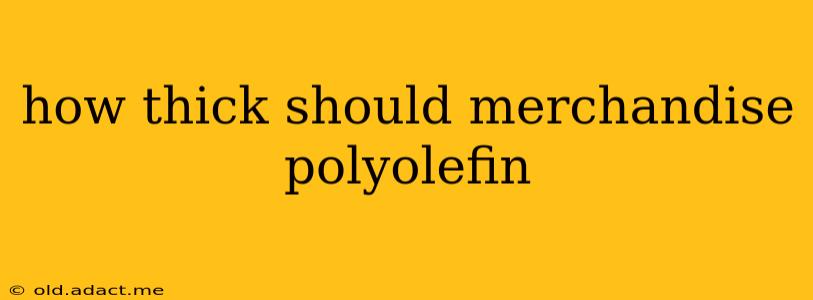How Thick Should Merchandise Polyolefin Bags Be?
Choosing the right thickness for your merchandise polyolefin bags is crucial for protecting your products, enhancing your brand image, and ensuring cost-effectiveness. The ideal thickness depends on several factors, and there's no one-size-fits-all answer. Let's explore the key considerations to help you determine the perfect gauge for your needs.
What are Polyolefin Bags?
Before diving into thickness, let's briefly define polyolefin bags. These bags are made from a blend of polymers, primarily polyethylene and polypropylene. This combination results in a durable, flexible, and versatile packaging option suitable for a wide range of merchandise. Their strength, moisture resistance, and clarity make them a popular choice for many businesses.
What Factors Determine the Necessary Thickness of Polyolefin Bags?
Several factors influence the ideal thickness for your merchandise polyolefin bags:
-
Product Weight and Size: Heavier and larger items require thicker bags to prevent tearing and ensure secure containment. A lightweight t-shirt might only need a relatively thin bag, while a heavy ceramic mug would necessitate a much thicker one.
-
Product Shape and Sharp Edges: Items with sharp edges or unusual shapes are more likely to puncture thinner bags. Consider a thicker gauge if your products have the potential to tear the bag.
-
Handling and Shipping: Bags subjected to rough handling during shipping or distribution benefit from increased thickness for added protection. Think about the journey your product will take and choose a thickness to withstand potential damage.
-
Branding and Printing: If you plan on printing your logo or other designs on the bags, a thicker bag will provide a more stable surface for high-quality printing. Thinner bags might wrinkle or distort the print.
-
Budget: Thicker bags typically cost more. Finding a balance between sufficient protection and cost-effectiveness is essential.
What are the Common Thicknesses (Gauge) for Polyolefin Bags?
Polyolefin bags are usually measured in mils (thousandths of an inch). Common thicknesses range from 1.5 mils to 4 mils or even higher, depending on the manufacturer and specific blend of polymers. Thinner bags are more economical but offer less protection, while thicker bags offer superior durability at a higher cost.
How Do I Choose the Right Thickness?
The best way to choose the appropriate thickness is to conduct some testing. Obtain samples of different gauges from a supplier and test them with your products. Consider the following:
- Fill the bags with your merchandise.
- Handle the bags as they would be handled during shipping and distribution.
- Check for tears or punctures.
- Assess the overall strength and protection offered.
This hands-on approach allows you to determine the minimum thickness necessary to safeguard your products effectively.
What if I'm Unsure About the Best Thickness?
If you're still unsure, consult with a reputable packaging supplier. They can offer expert advice based on your specific needs and provide samples of appropriate thicknesses to test.
By carefully considering these factors and conducting thorough testing, you can confidently choose the optimal thickness for your merchandise polyolefin bags, ensuring both product protection and brand presentation. Remember to always prioritize product safety and customer satisfaction.
